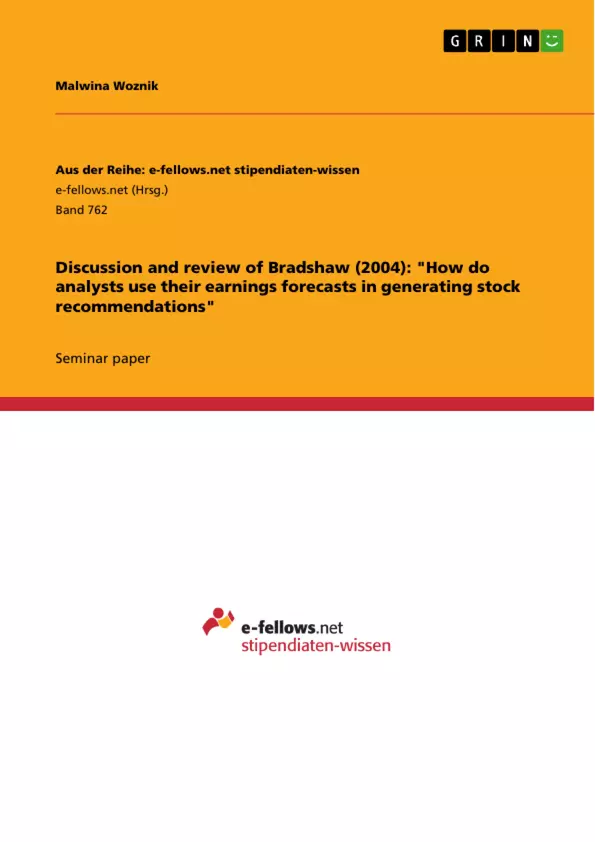Since the beginning of the 90s research on issues referring to analysts’ practise grew rapidly to such an extent that even several publications are concerned with giving an overview of this development. Besides the principal-agent problematic between the firm’s managers and the equity investors, investors are dependent on analysts’ information in times where equity trading soared and the trading turnover in 2008 was 35 times higher than in 1980. That is why shareholders are not able to analyse the amount of information regarding a company due to lack of time or ability. Therefore analysts advise investors to make a profitable decision by publishing a report including for instance stock recommendations or earnings forecasts. Another reason why there is so much research about analysts’ practise is the fact that their information influences investors’ trading behaviour. Thus, it is crucial to know how reliable those statements are and accordingly to be able to assess the quality of the outputs. However, to answer the question of analysts’ process of transforming various information of stock recommendations have to be examined in detail.
Recent investigations rather focus on the single properties of analysts’ analyses as earnings forecasts and stock recommendations, but did not connect those two values. Prior studies deal with research questions like the effect of earnings forecasts on the stock prices or the use of stock recommendations to foretell abnormal return. Bradshaw (2004) is the first research paper which follows the question whether there is a link and if so how analysts incorporate the earnings forecasts into their stock recommendation. Because of the importance of Bradshaw (2004), this paper reviews the main issues and embeds them into the existing literature concerning the role of analysts.
The rest of this paper is organized as follows. The first chapter focuses on the character of analysts and potential key input factors which might be used by analysts for issuing recommendations. Then a brief review of Bradshaw (2004) is given to present the main results. This enables a discussion about potential and realized extensions in literature which follows in the third chapter. The final chapter concludes.
Inhaltsverzeichnis (Table of Contents)
- Introduction
- Analysts' practise
- The character of financial analysts
- Key input factors of recommendations
- Review of Bradshaw (2004)
- Valuation models
- Present value models
- Heuristic models
- Fundamentals of the research
- Hypothesis
- Overview of the data
- Statistical analyses and results
- Valuation models and stock recommendations
- Valuation models and future exceed returns
- Valuation models
- Critical review
- Criticism referring to Bradshaw (2004)
- Possible extensions based on Bradshaw (2004)
- Conclusion
Zielsetzung und Themenschwerpunkte (Objectives and Key Themes)
This seminar paper aims to review and analyze the research conducted by Bradshaw (2004) on the use of earnings forecasts by financial analysts in generating stock recommendations. The paper critically examines the methodologies and findings of the study and explores potential extensions. Key themes and objectives of this work include:- Analyzing the role of financial analysts in investment decision-making
- Investigating the relationship between valuation models and stock recommendations
- Exploring the impact of valuation models on future excess returns
- Critically assessing the strengths and limitations of the research conducted by Bradshaw (2004)
- Proposing potential extensions and future research directions based on Bradshaw's work
Zusammenfassung der Kapitel (Chapter Summaries)
- Introduction: This chapter introduces the topic of the seminar paper and outlines the research question: how do analysts use their earnings forecasts to generate stock recommendations? The chapter also provides an overview of the structure and organization of the paper.
- Analysts' Practise: This chapter delves into the role of financial analysts in capital markets. It explores the character of these professionals and the key input factors they consider when formulating stock recommendations.
- Review of Bradshaw (2004): This chapter provides a detailed review of Bradshaw's research on analysts' use of earnings forecasts. It summarizes the methodologies employed, the data utilized, and the key findings.
- Valuation Models: This section examines the different valuation models employed by financial analysts, including both present value models and heuristic models.
- Fundamentals of the Research: This section outlines the hypothesis and data used in Bradshaw's research, providing insights into the underlying assumptions and research design.
- Statistical Analyses and Results: This section presents the statistical analyses conducted by Bradshaw and the resulting findings regarding the relationship between valuation models and stock recommendations, as well as their impact on future excess returns.
- Critical Review: This chapter provides a critical review of Bradshaw's research, highlighting strengths, weaknesses, and limitations. It also discusses potential extensions and future research directions based on the study's findings.
Schlüsselwörter (Keywords)
This seminar paper explores the use of earnings forecasts by financial analysts, particularly in generating stock recommendations. The focus is on the relationship between different valuation models and their impact on future excess returns. Key concepts include financial analysts, earnings forecasts, stock recommendations, valuation models, present value models, heuristic models, statistical analysis, and excess returns.- Arbeit zitieren
- Master of Science Malwina Woznik (Autor:in), 2011, Discussion and review of Bradshaw (2004): "How do analysts use their earnings forecasts in generating stock recommendations", München, GRIN Verlag, https://www.grin.com/document/231304



